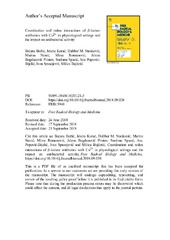Prikaz osnovnih podataka o dokumentu
Coordination and redox interactions of β-lactam antibiotics with Cu2+ in physiological settings and the impact on antibacterial activity
| dc.creator | Božić, Bojana | |
| dc.creator | Korać, Jelena | |
| dc.creator | Stanković, Dalibor | |
| dc.creator | Stanić, Marina | |
| dc.creator | Romanović, Mima | |
| dc.creator | Pristov-Bogdanović, Jelena | |
| dc.creator | Spasić, Snežana | |
| dc.creator | Popović-Bijelić, Ana | |
| dc.creator | Spasojević, Ivan | |
| dc.creator | Bajčetić, Milica | |
| dc.date.accessioned | 2019-05-13T15:16:57Z | |
| dc.date.available | 2019-09-23 | |
| dc.date.issued | 2018 | |
| dc.identifier.issn | 0891-5849 | |
| dc.identifier.uri | https://cherry.chem.bg.ac.rs/handle/123456789/2940 | |
| dc.description.abstract | An increase in the copper pool in body fluids has been related to a number of pathological conditions, including infections. Copper ions may affect antibiotics via the formation of coordination bonds and/or redox reactions. Herein, we analyzed the interactions of Cu2+ with eight β-lactam antibiotics using UV–Vis spectrophotometry, EPR spectroscopy, and electrochemical methods. Penicillin G did not show any detectable interactions with Cu2+. Ampicillin, amoxicillin and cephalexin formed stable colored complexes with octahedral coordination environment of Cu2+ with tetragonal distortion, and primary amine group as the site of coordinate bond formation. These β-lactams increased the solubility of Cu2+ in the phosphate buffer. Ceftazidime and Cu2+ formed a complex with a similar geometry and gave rise to an organic radical. Ceftriaxone-Cu2+ complex appears to exhibit different geometry. All complexes showed 1:1 stoichiometry. Cefaclor reduced Cu2+ to Cu1+ that further reacted with molecular oxygen to produce hydrogen peroxide. Finally, meropenem underwent degradation in the presence of copper. The analysis of activity against Escherichia coli and Staphylococcus aureus showed that the effects of meropenem, amoxicillin, ampicillin, and ceftriaxone were significantly hindered in the presence of copper ions. The interactions with copper ions should be taken into account regarding the problem of antibiotic resistance and in the selection of the most efficient antimicrobial therapy for patients with altered copper homeostasis. © 2018 Elsevier Inc. | en |
| dc.publisher | Elsevier | |
| dc.relation | info:eu-repo/grantAgreement/MESTD/Basic Research (BR or ON)/173014/RS// | |
| dc.relation | info:eu-repo/grantAgreement/MESTD/Basic Research (BR or ON)/173017/RS// | |
| dc.relation | info:eu-repo/grantAgreement/EC/FP7/621375/EU// | |
| dc.rights | embargoedAccess | |
| dc.rights.uri | https://creativecommons.org/licenses/by-nc-nd/4.0/ | |
| dc.source | Free Radical Biology and Medicine | |
| dc.subject | Antibiotic | en |
| dc.subject | Complex | en |
| dc.subject | Copper | en |
| dc.subject | EPR spectroscopy | en |
| dc.subject | Free radicals | en |
| dc.title | Coordination and redox interactions of β-lactam antibiotics with Cu2+ in physiological settings and the impact on antibacterial activity | en |
| dc.type | article | |
| dc.rights.license | BY-NC-ND | |
| dcterms.abstract | Спасојевић, Иван; Бајчетић, Милица; Пристов-Богдановић, Јелена ; Божић, Бојана; Романовић, Мима Ц.; Спасић, Снежана; Поповић-Бијелић, Aна; Кораћ, Јелена; Станковић, Далибор; Станић, Марина; | |
| dc.citation.volume | 129 | |
| dc.citation.spage | 279 | |
| dc.citation.epage | 285 | |
| dc.identifier.wos | 000450298400026 | |
| dc.identifier.doi | 10.1016/j.freeradbiomed.2018.09.038 | |
| dc.citation.other | 129: 279-285 | |
| dc.citation.rank | M21 | |
| dc.description.other | This is the peer-reviewed version of the following article: Božić, B.; Korać, J.; Stanković, D. M.; Stanić, M.; Romanović, M.; Pristov, J. B.; Spasić, S.; Popović-Bijelić, A.; Spasojević, I.; Bajčetić, M. Coordination and Redox Interactions of β-Lactam Antibiotics with Cu2+ in Physiological Settings and the Impact on Antibacterial Activity. Free Radical Biology and Medicine 2018, 129, 279–285. [https://doi.org/10.1016/j.freeradbiomed.2018.09.038] | |
| dc.description.other | Supplementary material: [http://cherry.chem.bg.ac.rs/handle/123456789/2941] | |
| dc.type.version | acceptedVersion | en |
| dc.identifier.scopus | 2-s2.0-85054184646 | |
| dc.identifier.fulltext | https://cherry.chem.bg.ac.rs/bitstream/id/6852/10.1016@j.freeradbiomed.2018.09.038.pdf |


